3.28.11 Meaty Monday: Brining, Rubbing, Smoking
For the current Charcutepalooza challenge, we've moved on from simple salt curing and brining to the added step of hot smoking. Given a choice of making tasso ham or Canadian bacon, I made both. Perhaps I should say "we," as without G's smoking prowess I would just have lots of incredibly well-seasoned but essentially raw pork on hand. Having come out the other side of this process, I have to tell you how incredibly rewarding it is. The meat is so delicious, and it was great fun to see it through the relatively few simple steps it took to create all this rich and complex flavor. If you held a gun to my head, I think I'd have to admit I prefer the tasso—it's made from pork shoulder (otherwise known as Boston butt, the same cut we use for our July 4th pulled pork), and slow-cooking melts its generous fat through every fiber. I can't wait to use it in some traditional recipes like gumbo or jambalaya. The Canadian bacon is also remarkably good, especially when you consider that every bit of fat has been removed. I added an extra rub to mine, just a simple mixture of brown sugar, cayenne and cumin, but I like the extra kick it gives the smoky pink meat.
Tasso ham is a specialty of Cajun cuisine. Ham is actually something of a misnomer, since tasso is not made from the hind leg of a pig. I sliced mine across the grain into 3 slimmer pieces, dredged them in a salt cure, then rinsed them, rubbed them with spices and hot-smoked them for a few hours. Although the recipe (from Charcuterie) has you go right from rubbing the meat with spices to smoking it, I let mine sit in the spice rub (white pepper, cayenne, marjoram and allspice) for a few days. The guys at Dickson's say they leave theirs for a month (!) so I thought I should at leave mine for at week.
The tasso is unbelievably juicy and flavorful, fairly bursting with rich, meaty, spicy smells and tastes.
I couldn't leave the Canadian bacon well enough alone, either. This is meant to get a good 2-day brining (since all the fat is removed) in a pot of salted water mixed with sugar, garlic, thyme and sage. After that, the recipe from Charcuterie calls for you to dry it out in the fridge for a couple of days before smoking. I brined it for longer (logistical miscalculation) and then couldn't resist giving it a little spice rub, too. I mixed up some dark brown sugar, cayenne and cumin. I let that sink in for a few days before handing it over to my Master Smoker.
This turned out to be amazingly delicious as well! As you imagine, Canadian bacon is not called that in Canada, where it's know as back bacon. It qualifies as such even if it's simply a brined and roasted loin; the smoking is optional, but not to be missed, if you ask me. G and I tromped out to an old orchard that's in a small meadow in the woods back of our house and brought back a huge dried bough of apple wood. He used that and some hickory chips to smoke these meats. Swaddled in a Brooklyn sweatshirt and a big wool cap, he sipped a little Pappy Van Winkle bourbon to keep warm and read the Sunday Times as he maintained the temp in our Weber grill at 200º for about three hours.
When I purchased my pork loin, it came virtually encased in a creamy layer of fat, about 2 inches thick. It cut away easily enough, but then I was left with about 2 pounds of the stuff. It seemed criminal to simply chuck it, so I pulled out Fat: An Appreciation of a Misunderstood Ingredient, With Recipes by the wise and wonderful (and winsome) Jennifer McLagan and looked into rendering lard. This is something you should only ever endeavor to do with the very best quality pig fat. Lard is an excellent source of vitamin D and makes a banging pie crust, the best ever.
To render lard, you simply place the pig fat and a small quantity of water in a low oven and let it slowly melt. I was intrigued by a side bar, citing Mexican cooking authority Rick Bayless on the merits of rendering at a slightly higher temp, which browns it a bit and gives it more of a roasted pork flavor. This is especially good for making your own tamales or incorporating in dishes like refried beans. Since I already have a few tubs of neutral lard on hand in the freezer, I decided to give this a shot. The byproduct of all this rendering—aside from the lard, of course—are the cracklings. They were actually kind of foul and got tossed. If you leave the skin on the fat, then you get the real cracklings that actually have some flavor. I mean, enough is enough, when it comes to pork and every other thing. Except maybe smoking.TASSO HAMfrom Charcuterie by Michael Ruhlman and Brian Polcyn5 pounds boneless pork shoulder butt, slice crosswise into 5 even slabsBasic Dry Cure* for dredging, about 2 cups3 tablespoons ground white pepper1 1/2 tablespoons cayenne pepper3 tablespoons dried marjoram3 tablespoons ground allspiceDredge the pork in the dry cure, pressing it into the cure to make it adhere, and shake off the excess. The surface of each piece should be coated with an even layer of cure. Refrigerate, covered for 4 hours.Rinse the pork under cold water, brushing off any remaining dry cure, and pat dry with paper towels.Combine the remaining ingredients in a shallow bowl, mixing well. Dredge the meat on all sides in the spices so that the pieces are uniformly coated. (GFL note: Here is where I wrapped mine in saran and left to cure in the fridge for almost a week.)Hot-smoke the pork to an internal temperature of 150º. The ham will keep for several weeks refrigerated and for several months in the freezer.*BASIC DRY CURE1 pound kosher salt8 ounces sugar2 ounces pink curing salt (10 teaspoons)







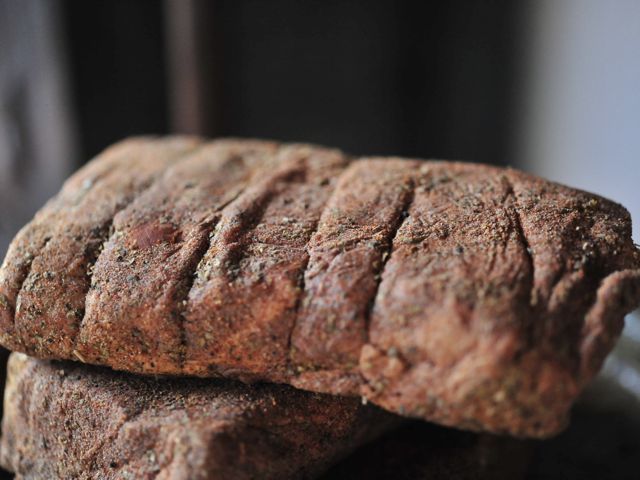
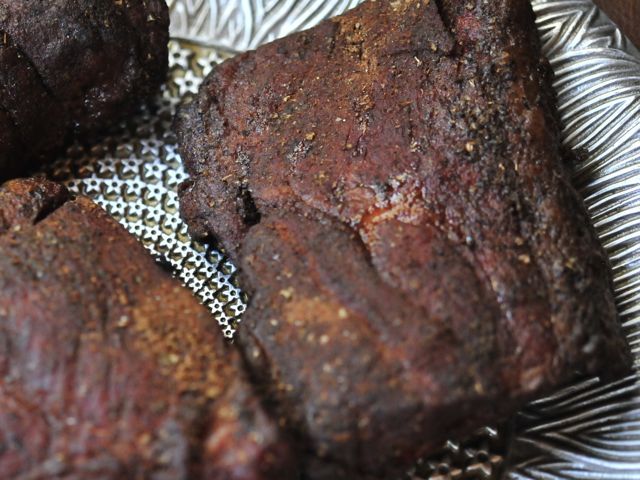
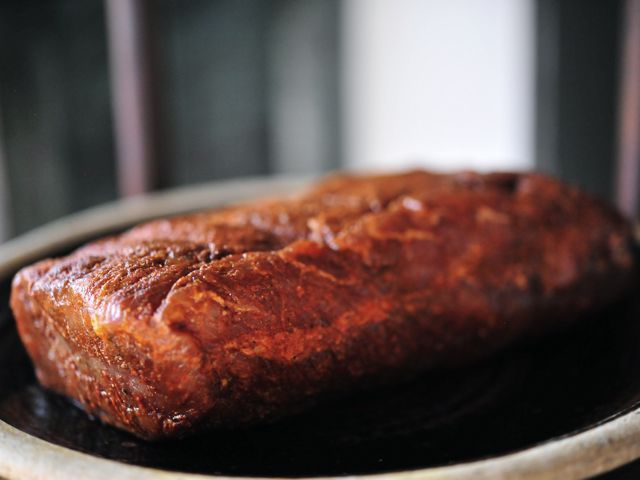
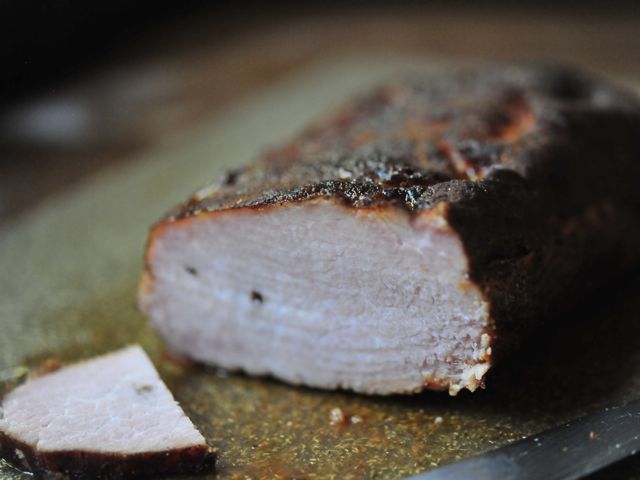
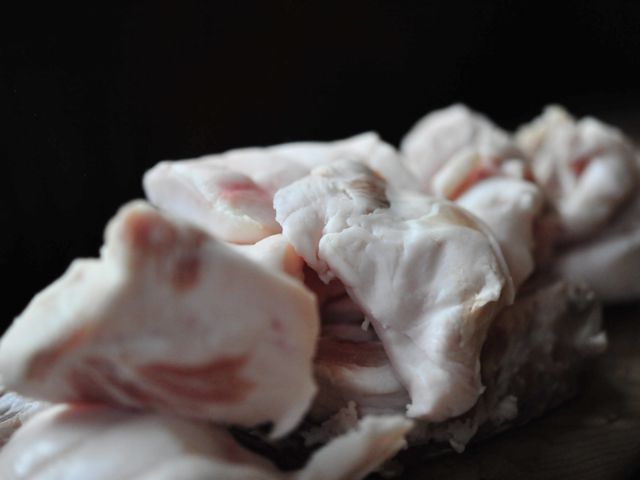
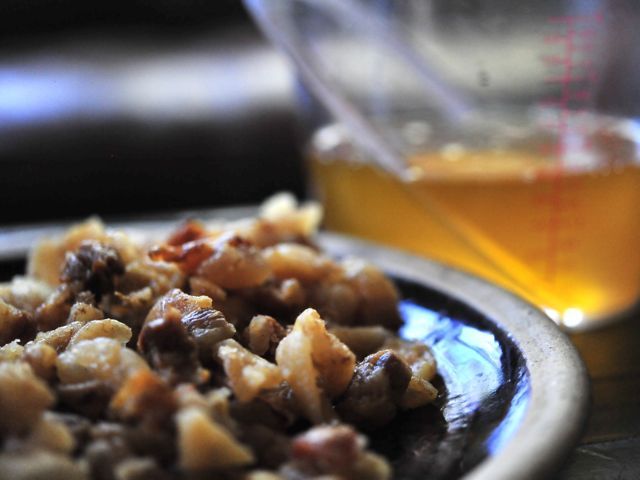
2 Comments